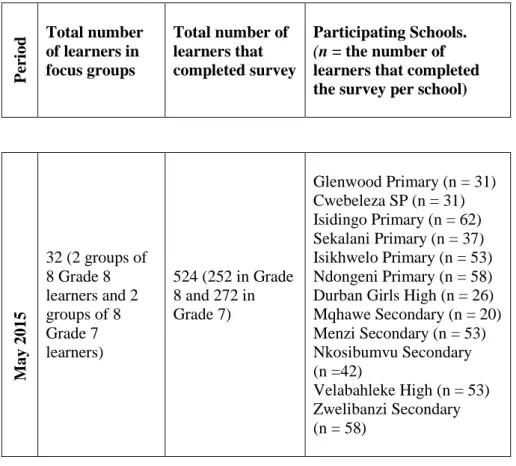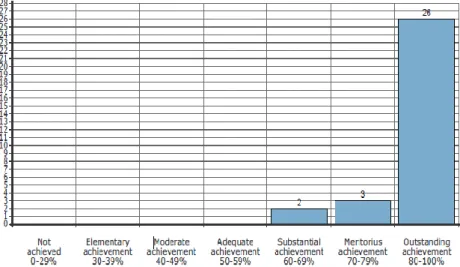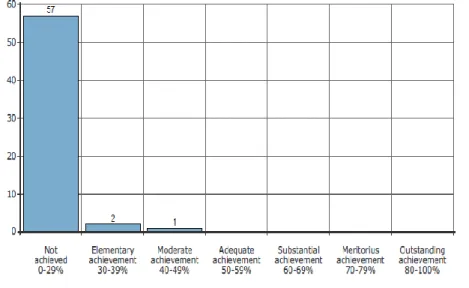What is the effectiveness of the tablet-based digital content for students and teachers in math, science and English. The study aimed to understand the effectiveness of the tablet-based digital content on teachers and students and consequently to make recommendations for sustainable, scalable eLearning models. The project assessment was carried out in two phases: assessment of the first use of the digital content by teachers; and follow-up assessments of the use of the digital content by teachers and students.
To address the first research question, qualitative data was collected during the initial use of the digital content by teachers in order to analyse: the implementation challenges; user experience across the three subjects; and how the digital content was used across the three subjects. Furthermore, quantitative data was collected in order to analyze the frequency of use of the digital content across the three subjects. How did the teachers and learners experience the implementation of the tablet-based digital content?
What was the effectiveness of the digital content in helping the teacher to deliver the curriculum on time.
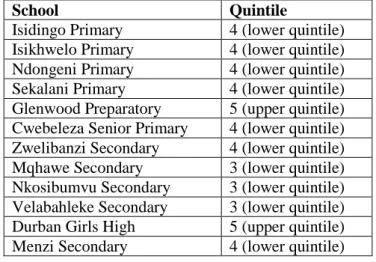
Paper-based Surveys
Classroom Observations
Examination
Equipment and Support Materials Used
Baseline Assessment
Among the learners, pre-intervention assessment was measured according to six criteria: home technology access; digital literacy level; day-to-day learning aids; previous technology use in the classroom; peer assistance with technology; and prior digital awareness. A survey of home technology access among teachers and learners investigated how and what technology teachers and learners have access to outside the classroom. Digital literacy level was measured among teachers and learners and examined the level of literacy from most comfortable to least comfortable.
The former level of technology initiative among teachers assessed how teachers created technology awareness among their students and the frequency of increased awareness of rules governing digital use. Prior development of technology skills among teachers was assessed by whether the teacher had formal or informal ICT training. Assessment of daily learning tools among students assessed which ICT tools students normally use.
Further, assessment was conducted to examine the level of peer assistance with technology among students and their prior digital awareness.
Project Assessment
Beliefs and classroom behaviors in all three subjects were assessed to understand practice in the sense of working together to solve a problem, sharing knowledge, how homework is done, and how projects are done. Implementation challenges ranked the initial experience with tablets and digital content from least challenging to most challenging. User experience was assessed by teachers rating their user experience based on various statements such as ease of e-book navigation, ranging from strongly disagree to strongly agree.
The frequency of use of digital content in the three subjects was measured by examining the frequency of use of different e-learning programs installed on the tablet. The continued use of digital content by teachers was measured according to ten metrics: teachers' trust in digital content; current level of technology initiative among teachers; development of current technological skills;. In order to analyze the impact of digital content on the teaching style, an evaluation of the integration of ICT into the teaching style of teachers was carried out.
Baseline Results
Consistent with South African school age, the majority of the sample was 12 or 13 years old. There was one 16-year-old pupil, but because of the small sample, the percentage is not visible in figure 3.4. Consistent with South African school age, the majority of the sample was 13 years old.
Glenwood Preparatory Mqhawe High School Nkosibomvu Secondary School Sekalani SP School Velabahleke High School Zwelibanzi High School Durban Girls High School Cwebezela SP School.
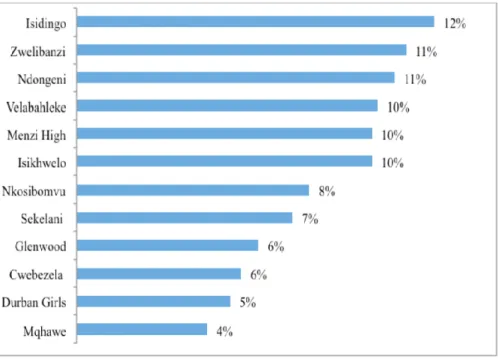
Baseline Assessment Results
The difference in performance between higher and lower quintile schools is further evidenced in the learner performance distribution per category. For example, Figure 5 shows a graphical view of the distribution of scores of a class in Grade 8 English test at Durban Girls High School. In contrast, Figure 6 shows a graphical view of the distribution of scores of a class in Grade 8 English test at Menzi Secondary.
The results show that students at Durban Durban Girls High School had outstanding performance in the subject, while students at Menzi Secondary did not achieve above 29%.
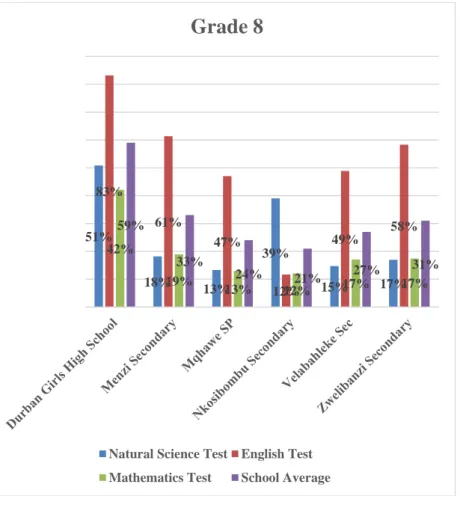
Digital Infrastructure
In relation to the baseline test and the improved assessment results reported in section 3.2.1, it is evident that the level of digital infrastructure previously provided by the school influences the opportunity for optimal use of the e-learning resource. Schools with better digital infrastructure and its use showed a higher level of integration of the eLearning resource.
Overall Classroom Challenges
Classroom Beliefs and Behaviours
Limitation of use Not being able to take devices home limits class preparation and affects time management. Inability of students to take devices home for homework - unable to make the device and content "theirs" Low level of familiarity with device management. Difficulty integrating device usage and content with current technology and content.
Participate in problem solving Encourage knowledge sharing Homework is done in class Homework is done at home.
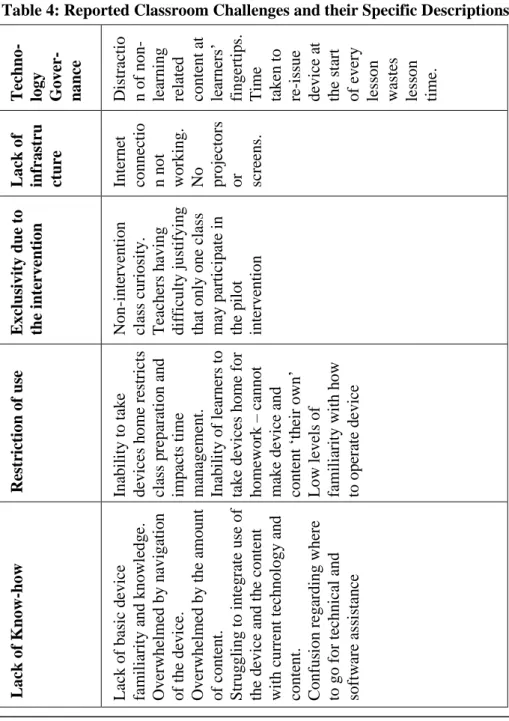
Digital Literacy Level Teachers
Initial Assessment Results Implementation Challenges
Based on classroom observations, it was also evident that teachers, while using the resources provided, had little knowledge of how to use the applications available on the devices. Although students were more proficient in these, they had little knowledge of applications such as Excel and PowerPoint.
Assessments with Learners and Teachers from May to September
Glenwood Prep
Cwebeleza Primary
Durban Girls High School
Durban Girls High
In both June and December, classes with tablets outperformed classes without tablets in all three subjects. These results show evidence that students who used the e-learning research pilot benefited from its use and were consequently able to perform better in the subject than those who were not exposed to the e-learning research pilot.
Comparison of June and December Exam Results at Durban Girls High
School
Students in classes with and without tablets performed the same or slightly better than each other. The introduction of ICT does not seem to have had a negative impact on the tablet classes. Other studies have suggested that the positive effects of laptop use did not emerge until after the second year of a recent ICT implementation study due to the steep learning curve required for teachers and students experiencing the new 1:1 classroom.
This indicates that although the results at Isidingo Primary did not show significant differences between tablet and non-tablet classrooms, this is likely to change with future implementations of the Pearson/MSA eLearning research pilot.
Comparison of June and December Exam Results at Isidingo Primary
An analysis of student performance in the baseline measurement and post-test assessment shows that students in the tablet classes improved their results across all subjects and schools, while students in the non-tablet classes showed a decrease. The biggest discrepancy is in Grade 7 Natural Science and Grade 8 Maths, where students in the tablet classes particularly outperformed cohorts in non-tablet classes.
Conclusion
What was the standard of learner achievement and competence in terms of subject-specific skills and ICT skills. The exam results indicate that the intervention has an impact on the learners' subject-specific skills. Furthermore, the feedback from the teachers and learners indicates that learners have acquired digital literacy, not only in using the eLearning solutions, but also in creating knowledge and acquiring problem-solving skills.
Recommendations
Learning
For students, there is an opportunity to design collaboration and sharing tools for limited spaces, such as in libraries or during quiet sessions. The volume and variety of content included in any eLearning solution should be tailored to the users' abilities. For teachers, the integration of digital content can be at any of the three stages: Stage 1 (not comfortable integrating the digital content into the classroom); Step 2 (felt comfortable integrating some of the digital content into the class); and step 3 (felt comfortable integrating the digital content into the classroom).
Therefore, the teachers at the different stages should be exposed to digital content appropriate to the stage they are in. As teachers progress through the three stages, they should be able to select and use additional digital content appropriate to an advanced level. To minimize disruption and maximize learning and teaching time, we recommend the following: provide guidance on how to link digital resources to the delivery of the CAPS curriculum; and provide a search functionality that allows users to search for digital assets by term, subject, grade, and CAPS topic.
An e-learning solution should facilitate learning outside the classroom and provide student-led repetition and practice. To accomplish this, it is recommended that stakeholders work with schools to identify access to technology across the school. Additionally, access to mobile-friendly content accessible across devices is recommended to enable learning outside of the classroom.
Thus, it is recommended to use students' enthusiasm and technical knowledge to drive change and support teachers. Teachers and students need education about ethical and responsible use of the Internet and a better understanding of what it means to be online. So the digital capability of users varies: analysis of user needs to determine the focus of training and support is essential; training must be continuous and practical to move from a stage 1 user to a stage 3 user; training programs should be tailored to different users (teachers, students, HODs, IT administrators); and successful teacher training considers technological knowledge, pedagogical knowledge, and content knowledge.
Personal Note by the Lead Author
Attitudes and self-reported competencies of teachers in rural schools in KwaZulu-Natal regarding the use of information communication technology to deliver rural e-education. The technology architecture to support the implementation of e-learning in a developing country: A critical study of the South African province of Kwazulu-Natal. Evaluation of f Attitudes and knowledge levels of Kwazulu-Natal urban public school teachers regarding information communication technologies as applied to e-education.

